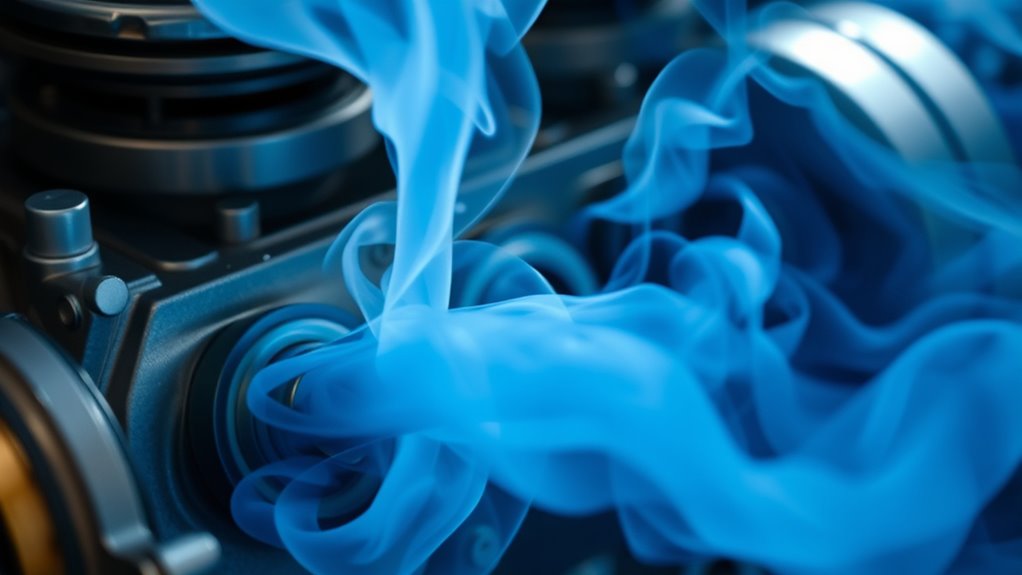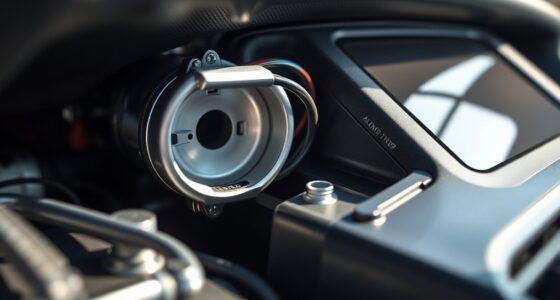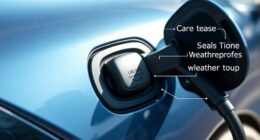Blue smoke on startup usually means oil is burning inside your engine. If it clears quickly as the engine warms up, it’s likely due to worn valve seals, which leak oil into the combustion chamber when cold. If the smoke persists or appears during or after warm-up, a turbocharger seal leak might be the cause. Understanding these differences can help you diagnose the issue more accurately—keep exploring to find out how to fix it effectively.
Key Takeaways
- Blue smoke at startup that diminishes suggests worn valve seals; persistent smoke indicates turbo seal or bearing issues.
- Valve seal problems cause oil to leak into cylinders only during startup, reducing as the engine warms.
- Turbocharger issues often produce blue smoke during or after warm-up, sometimes with loss of boost and additional noises.
- Signs like smoke during acceleration or engine power loss point more toward turbo-related oil leaks.
- Valve seal repairs are generally simpler; turbo repairs may involve replacing seals or entire turbo units.

Have you ever noticed blue smoke rising from your engine during startup? If so, you’re probably wondering what’s causing it. Blue smoke typically indicates oil burning inside the engine, and it’s important to identify the source quickly before it leads to more serious engine problems.
Blue smoke during startup signals oil burning—identify the cause promptly to prevent engine damage.
Two common culprits are worn valve seals and turbocharger issues, but understanding the difference can help you diagnose and fix the problem effectively. Recognizing emotional support needs during vehicle problems can also help you stay calm and focused on resolving the issue.
If the blue smoke appears immediately upon startup and diminishes as the engine warms up, worn valve seals are likely the cause. Valve seals prevent oil from leaking into the combustion chamber through the valve guides. Over time, heat and wear cause these seals to deteriorate, allowing oil to seep past and burn during ignition.
When you start the engine, oil trapped around the valves burns off, creating blue smoke. As the engine warms and the oil burns away, the smoke reduces or stops altogether. This issue is often more noticeable in older vehicles or ones with high mileage, where the seals have had a lot of time to degrade. Replacing valve seals is a repair that requires some mechanical skill, but it’s usually straightforward for a seasoned mechanic.
On the other hand, if the blue smoke persists even after the engine has warmed up, or if it appears during acceleration, the turbocharger could be at fault. Turbochargers are designed to force more air into the engine, boosting power, but they contain oil-lubricated bearings.
If these seals or bearings fail, oil can leak into the intake system and burn during combustion, producing blue smoke. Unlike valve seal issues, turbo-related smoke might be more persistent and may worsen over time. You might also notice a loss of boost pressure, a decrease in power, or unusual whining noises from the turbo.
Addressing turbo problems can be more complex; it often involves inspecting and possibly replacing the turbo unit or its seals. Additionally, seeking professional support can help manage the emotional stress of vehicle repairs and ensure safe, effective solutions.
Frequently Asked Questions
Can Blue Smoke on Startup Indicate Both Valve Seal and Turbo Issues?
Yes, blue smoke on startup can indicate both valve seal and turbo issues.
If valve seals are worn, oil leaks into the combustion chamber, causing smoke.
Similarly, a turbo that’s failing or has worn seals can also allow oil to enter the intake, producing blue smoke.
You should inspect both components to determine the exact cause, as addressing either issue can improve your engine’s performance and reduce smoke.
How Long Does Blue Smoke Typically Last During Startup?
Like a flickering candle at dawn, blue smoke on startup usually lasts a few seconds to a minute.
If it persists longer, you might have an underlying issue, such as worn valve seals or turbo problems.
Keep an eye on it, and consider a professional inspection if the smoke lingers or worsens.
Quick action now can prevent more serious, costly repairs down the line.
Are There Any Preventive Measures to Avoid Blue Smoke at Startup?
Yes, you can prevent blue smoke at startup by regularly maintaining your engine. Change the oil and oil filter as recommended, since old or contaminated oil causes valve seals to deteriorate faster. Use high-quality oil that resists burning.
Also, make sure your turbo and valve seals are in good condition by having them inspected regularly. Proper warm-up procedures before driving can help reduce stress on engine components and prevent blue smoke.
Does Blue Smoke Always Mean Engine Damage?
Blue smoke doesn’t always mean engine damage. For example, if your car occasionally emits blue smoke on startup, it might be due to worn valve seals or turbo seals, which can be fixable.
However, persistent blue smoke indicates oil burning, risking engine damage over time. Regular maintenance and timely repairs help prevent serious issues, so pay attention to smoke patterns and address problems early.
Can Using Synthetic Oil Reduce Blue Smoke During Startup?
Yes, using synthetic oil can reduce blue smoke during startup because it flows more easily at cold temperatures, providing better lubrication for valve seals and piston rings. This helps prevent oil from leaking into the combustion chamber, minimizing smoke.
Regularly changing to synthetic oil and ensuring proper engine maintenance can further reduce blue smoke. However, if smoke persists, it’s best to have a mechanic inspect your engine for underlying issues.
Conclusion
Understanding whether your blue smoke on startup comes from valve seals or the turbo can save you time and money. Did you know that roughly 70% of engine issues stem from worn valve seals? Addressing the root cause early prevents costly repairs down the line. Keep an eye on those startup clouds—diagnosing promptly helps keep your engine running smoothly and extends its lifespan. Don’t ignore the signs; your engine will thank you for it.









